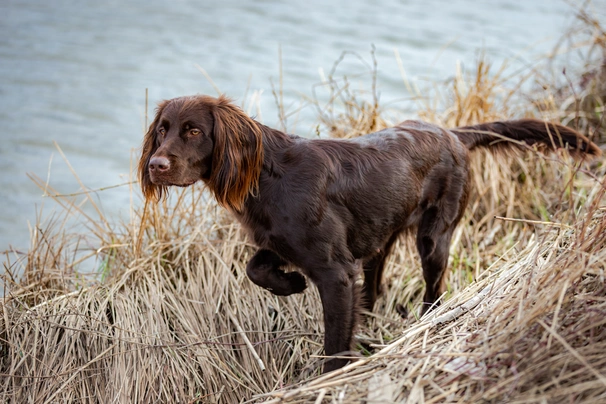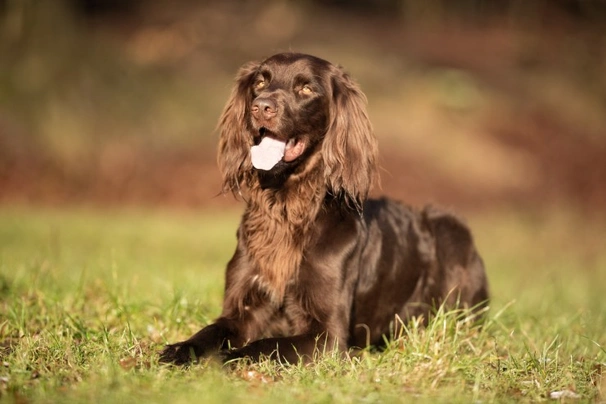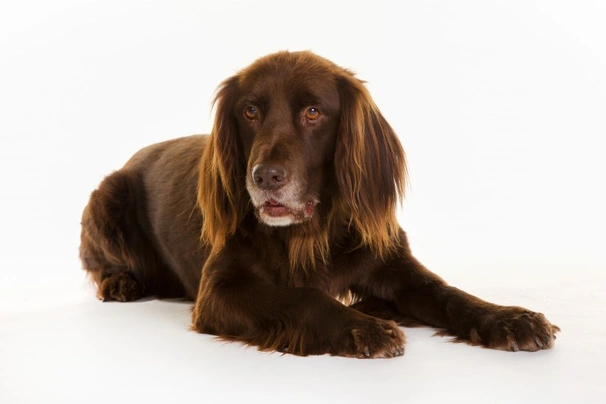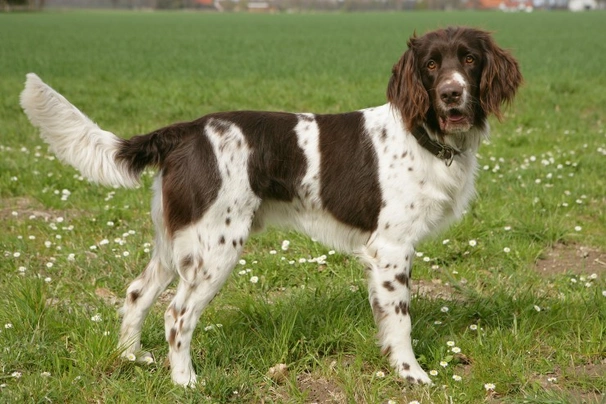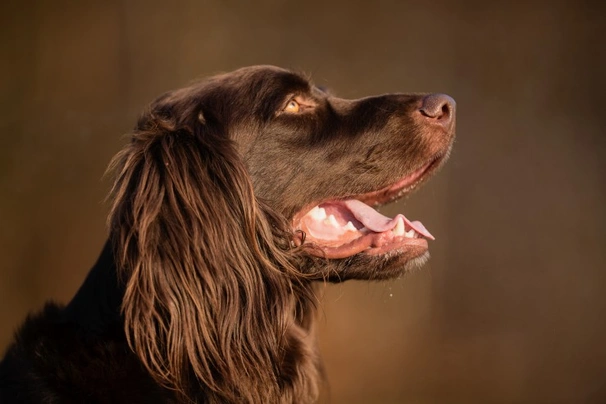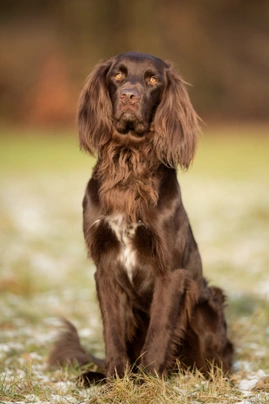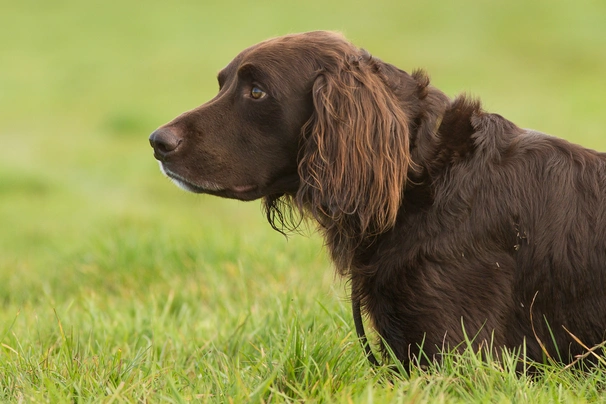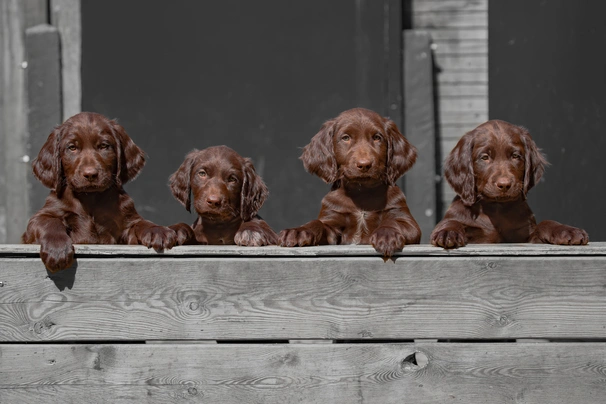German Longhaired Pointer
Pros
Cons
Introduction of the German Longhaired Pointer
The German Longhaired Pointer as their name suggests was first developed as a gundog in Germany where they have always been extremely highly prized not only as working dogs but as companions and family pets too. They are friendly loyal and intelligent dogs being just as home in a home environment as they are in the field. As such German Longhaired Pointers are starting to win a fanbase in the UK and other parts of the world.
However anyone wishing to share a home with a German Longhaired Pointer would need to have enough time to dedicate to these high energy dogs and it is worth noting they are not the best choice for first time owners. With this said not many GLP puppies are bred in the UK every year and as such they can often command a lot of money and anyone wanting to share a home with a German Longhaired Pointer would need to register their interest with breeders first.
History of the German Longhaired Pointer
Dogs have been used for hunting since the 4th and 5th Centuries when they were known as “bird dogs” or sometimes “hawk dogs”. There are some people who believe these hunting dogs were descendants of what is known as “Silk Dogs” from the highlands of Tibet. These dogs did not flush out game but rather stood still and pointed while other dogs flushed birds out first.
It was at the beginning of the 19th Century that hunting enthusiasts in Germany began a breeding programme to produce highly skilled gundogs and by the middle of the century a slim long dog with a large head and strong “nose” was developed. Although very pleasing to the eye these dogs were strong-willed headstrong and stubborn which made them that much harder to handle. With this said they were known to be hard working dogs no matter what the weather. Coat colours were originally brown and white black with white very much like the Spanish water dog.
Over time other breeds were introduced into the mix which included Pointers as well as English Setters and the various German associations set about establishing breed standards for each of their clubs always trying to promote dogs with the better hunting skills. The first of the gundogs were exhibited in Frankfurt in 1878 and then again in 1879 after which breeders set about further improving their dogs with an end goal being to improve their hunting abilities. Thanks to the efforts of breed and hunting enthusiasts the German Longhaired Pointer was a success and the dogs we see today can trace their ancestry to the best dogs used in breeding programmes back in the day.
The German Longhaired Pointer like their wirehaired and shorthaired cousins have always been highly prized not only in Germany but in other parts of the world including here in the UK as an exceptionally skilled gundog. The breed was first introduced to Britain in the 1980’s but was re-introduced in the 1990's before being officially recognised by The Kennel Club in 1997. There are three German Pointers with the Longhaired being just one of them and although they boast having different coat types the GLP was bred to be the largest of the three.
Today the German Longhaired Pointer remains a very popular working gundog not only in their native Germany but here in the UK where they are also often seen competing in field trials. These elegant noble dogs are also gaining popularity with people who lead active outdoor lives and who would like to share their country homes with an intelligent active canine companion. However anyone wishing to share a home with a GLP would need to register their interest with breeders first and go on a waiting list because so few puppies are bred every year.
Interesting facts about the breed
- Is the German Longhaired Pointer a vulnerable breed? No although they are quite rare in the UK and well-bred puppies can therefore command a lot of money
- A German Longhaired Pointer won the Hunt Point and Retrieve Championship
- The breed is known to be the “Ferrari” of all gundog breeds
- There are only 2 acceptable breed colours namely white and brown in all sorts of combinations
- German Longhaired Pointers are strong powerful dogs that can cover a tremendous amount of ground when they need to
- Traditionally a GLP’s tail was always docked but since the law banning the procedure came into effect in 2007 tail docking is now illegal with the exception being for some working breeds and if a dog suffers from some sort of health issue that requires their tails to be docked. The procedure must be agreed and authorised before being performed by a qualified vet without which anyone owning a GLP would be liable to heavy fines
Appearance of the German Longhaired Pointer
Height at the withers: Males 60 - 70 cm Females 58 - 66 cm
Average weight: Males 27 - 30 kg Females 27 - 30 kg
The German Longhaired Pointer is an athletic noble elegant well-muscled looking dog and one that boasts having a shiny medium length coat. Their heads have a very aristocratic look about them which adds to their overall charming appearance. The top of their heads is slightly domed with dogs not having a very pronounced stop. They have strong jaws and nice brown noses which can have a slight speckling to them. The hair on their heads is a lot shorter than on the rest of their body.
Their eyes are a dark brown and moderately large being oval shaped and tight eyelids. Their ears are set close and high on a dog's head being broad and turning slightly forwards with the leathers reaching as far down as the corner of a dog's mouth. The bottom edge of a dog's ears turns outwards and they are well feathered on the outside edges. The GLP has a strong jaw with a perfect scissor bite where their upper teeth neatly overlap their lower ones.
Their necks are moderately long being slightly arched and muscular with not dewlap merging smoothly into a dog's shoulders. Their shoulders are nicely sloping and muscular with dogs having straight nicely feathered front legs. They have strong bodies with well-developed sternums and nice deep and broad ribcages that reach well down to a dog's elbows. Their backs are level and moderately long being very well muscled around a dog's loins.
Their hindquarters are powerful with dogs having a long slightly sloping croup and nice straight strong back legs. Their feet are compact well arched and oval with dogs having strong pads and nails. They have a lot of hair between their toes which form tufts. Tails are nicely feathered and moderately long with dogs holding them in a slight scimitar shape being stronger at the root before tapering to the tip.
When it comes to their coat the German Longhaired Pointer has a close fitting top coat with a lush softer undercoat. The hair on their throat chest and stomach is longer than on the rest of the body where the hair is a lot sleeker and close lying. They can have either straight or slightly wavy hair and the back of their front and back legs are well feathered although below a dog's hocks the hair is shorter. The accepted breed colours for Kennel Club registration are as follows:
- Brown
- Brown & White
- Dark Brown Roan
- Trout Coloured Roan
- White Ticked
It is worth noting that the accepted breed colours for Kennel Club registration can differ from those set out in the breed standard which are as follows:
- Solid brown – with white markings on feet and chest
- Dark brown roan – with brown patches which can vary in size and blaze or star on brown head
- White – ticked with brown patches varying in size blaze or star on brown head
- Trout-coloured roan – with numerous brown patches (small) on white background blaze or star on brown head
- Brown and white – can either be clear or have brown patches (large) and fewer smaller patches blaze or star on brown head
Gait/movement
When a German Longhaired Pointer moves they take long free-moving strides displaying a tremendous amount of style and grace when they do and showing a good reach in the front and lots of drive from behind.
Faults
The Kennel Club frowns on any exaggerations or departures from the breed standard and would judge the faults on how much they affect a dog's overall health and wellbeing as well as their ability to perform.
Males should have both testicles fully descended into their scrotums and it is worth noting that a dog can be a little lighter or heavier as well as slightly taller or shorter than set out in the Kennel Club breed standard which is only given as a guideline.
Temperament of the German Longhaired Pointer
German Longhaired Pointers are intelligent fiercely loyal and friendly dogs. They form exceptionally strong bonds with their owners which does have a bit of a downside in that these handsome dogs tend to suffer from separation anxiety when their owners are not around. As such they do not do well when they are left on their own for any length of time and are best suited to families where at least one person stays at home when everyone else is out of the house. They also do better living in a more rural environment because they like to be out and about as much as possible for them to be truly happy well-balanced dogs.
Their socialisation must start when puppies are still young and it must include introducing them to lots of new situations noises people other animals and dogs once they have been fully vaccinated. The same goes for their training which must start early and which must be consistent throughout a dog’s life. However because the GLP is such an intelligent dog and one that loves to please in the right hands and environment they are easy to train and thrive on the one-to-one attention they are given during their training sessions.
They are known to have a bit of a stubborn streak in them which if left unchecked could see a dog becoming wilful and unruly which can make them that much harder to live with and handle. However with time patience and gentle training this side to their nature can be overcome. They are a good choice for first time owners providing they have enough time to dedicate to an active highly intelligent canine companion and one that needs to be given a ton of daily exercise and lots of mental stimulation for them to be truly happy well-rounded characters.
They can be a little stand-offish with people they do not know but rarely would a GLP show any sort of aggressive behaviour towards a stranger preferring to keep their distance until they get to know someone.
Are they a good choice for first time owners?
GLPs are not a choice for first time dog owners because they need to be socialised handled and trained by people who are familiar with their specific needs bearing in mind that they are high-energy dogs that need plenty of daily exercise and mental stimulation to be truly happy well-rounded dogs.
What about prey drive?
GLPs have been bred as gundogs and are highly skilled which means they have a high prey drive. The good news being that being so intelligent and trainable GLPs can be taught to “leave it” when told. With this said care should always be taken as to where and when a dog can run free more especially if there is wildlife and livestock close by.
What about playfulness?
GLPs have a very playful side to their natures and love to entertain and be entertained they also like to please and quickly learn how what is expected of them when handled correctly. With this said playtime can be a little boisterous when they are still young which means that dogs should be taught that games should be played outside and not indoors to prevent breakages.
What about adaptability?
GLPs are better suited to people who live in the country and who lead active outdoor lives because these dogs thrive on having something to do and must be given a tremendous amount of daily physical exercise combined with as much mental stimulation to prevent boredom from setting in.
What about separation anxiety?
Although GLPs form strong ties with their families they are not known to suffer from separation anxiety although no dog likes to spend too much time alone. With this said they are better suited to people who either work from home or in households where one person stays at home when everyone else is out so they typically always have someone around.
What about excessive barking?
Some GLPs like the sound of their own voices a little too much which is something that needs to be gently nipped in the bud when a dog is still young being careful not to frighten them. Others will only bark when there are strangers about or when something they don't like is going on in their surroundings.
Do German Longhaired Pointers like water?
German Longhaired Pointers love being in and around water no matter what the weather. However if anyone who owns a dog that does not like water should never force them to go in because it would just end up scaring them. With this said care should always be taken when walking a GLP off the lead anywhere near more dangerous watercourses just in case a dog decides to leap in and then needs rescuing because they cannot get out of the water on their own.
Are German Longhaired Pointers good watchdogs?
German Longhaired Pointers are natural watchdogs because they are alert and always wary of strangers and people they don’t know. However rarely would a GLP be aggressive preferring to keep their distance and bark.
Intelligence / Trainability of the German Longhaired Pointer
The German Longhaired Pointer is a very smart dog and a quick learner. The downside to this is they are just as quick to pick up bad habits as they are the good. They need to be well socialised from a young age and their training must begin early too. It also must be very consistent and always fair so that a dog understands what their owner expects of them. GLP's are never happier than when they are given something to do which is why they are so amenable to learning new things.
They excel at many canine sports which includes activities like flyball agility and obedience because they thrive on the attention they are given during their training and the one-to-one contact they have with their owners when they are competing. The key to successfully training a GLP is to make their training as interesting as possible and to avoid being too much repetition. It's also a good idea to keep training sessions shorter which helps keep a dog more focussed on what is being asked of them.
Like all puppies German Longhaired Pointers are incredibly cute and it is all too easy to spoil them when they first arrive in new homes. However adorable puppies grow up quickly to larger adult dogs which means that as soon as a puppy is nicely settled in owners must start out as they mean to go on by laying down rules and boundaries so a puppy understands what behaviours are acceptable and what are not. It also helps establish a pecking order and who is alpha dog in a household. The first commands a puppy should be taught are as follows:
- Come
- Sit
- Stay
- Heel
- Quiet
- Leave it
- Down
- Bed
Children and other
German Longhaired Pointers are known to be very good around children thanks to their gentle placid natures. However because of their large size any interaction between toddlers and a dog should always be well supervised by an adult to make sure playtime does not get too boisterous which could end up frightening a child or even injuring them albeit by accident.
They can be a little "off" with other dogs which is why it's so important for a GLP to be well socialised from a young age. If they have grown up with a family cat in a household they usually get on well together but they would think nothing of chasing off any other cats they come across. Care must be taken when a GLP is around smaller animals and pets because they might just see them as "fair game" as such any contact is best avoided.
Health of the German Longhaired Pointer
The average life expectancy of a German Longhaired Pointer is between 12 and 14 years when properly cared for and fed an appropriate good quality diet to suit their ages.
The GLP is known to be a healthy dog and one that does not seem to be affected by the kind of hereditary health issues that other pedigree dogs are known to suffer from. However it's important to restrict the amount of exercise a puppy or young dog is given to prevent too much pressure being put on developing joints which could lead to problems later in a dog’s life.
What about vaccinations?
GLP puppies would have been given their initial vaccinations before being sold but it is up to their new owners to make sure they have their follow-up shots in a timely manner with the vaccination schedule for puppies being as follows:
- 10 -12 weeks old bearing in mind that a puppy would not have full protection straight away but would be fully protected 2 weeks after they have had their second vaccination
There has been a lot of discussion about the need for dogs to have boosters. As such it's best to talk to a vet before making a final decision on whether a dog should continue to have annual vaccinations which are known as boosters.
What about spaying and neutering?
A lot of vets these days recommend waiting until dogs are slightly older before spaying and neutering them which means they are more mature before undergoing the procedures. As such they advise neutering males and spaying females when they are between the ages of 6 to 9 months old and sometimes even when a dog is 12 months old.
Other vets recommend spaying and neutering dogs when they are 6 months old but never any earlier unless for medical reasons. With this said many breeds are different and it is always advisable to discuss things with a vet and then follow their advice on when a dog should be spayed or neutered.
What about obesity problems?
Like other breeds GLPs can gain weight after they have been spayed or neutered and it's important to keep an eye on a dog's waistline just in case they do. If a dog starts to put on weight it's important to adjust their daily calorie intake and to up the amount of exercise they are given. Older dogs too are more prone to gaining weight and again it's essential they be fed and exercised accordingly because obesity can shorten a dog's life by several years. The reason being that it puts a lot of extra strain on a dog's internal organs including the heart which could prove fatal.
What about allergies?
Some GLPs are prone to suffering from allergies and it's important for a dog to see a vet sooner rather than later if one flares up. Allergies can be notoriously hard to clear up and finding the triggers can be challenging. With this said a vet would be able to make a dog with an allergy more comfortable while they try to find out the triggers which could include the following:
- Certain dog foods that contain high levels of grains and other cereal-type fillers
- Airborne pollens
- Dust mites
- Environment
- Flea and tick bites
- Chemicals found in everyday household cleaning products
Participating in health schemes
All responsible German Longhaired Pointer breeders would ensure that their stud dogs are tested for known hereditary and congenital health issues known to affect the breed before using them for breeding purposes.
What about breed specific breeding restrictions?
Apart from the standard breeding restrictions for all Kennel Club recognised breeds there are no other breed specific breeding restrictions in place for the German Longhaired Pointer.
What about Assured Breeder Requirements?
Currently there are no KC Assured Breeder requirements in place for the German Longhaired Pointer but all breeders should have their dogs tested for known hereditary and congenital health issues known to affect the breed.
Caring for the German Longhaired Pointer
As with any other breed German Longhaired Pointers need to be groomed on a regular basis to make sure their coats and skin are kept in top condition. They also need to be given regular daily exercise to ensure they remain fit and healthy. On top of this dogs need to be fed good quality food that meets all their nutritional needs throughout their lives.
Caring for a German Longhaired Pointer puppy
GLP puppies are boisterous and full of life which means it's essential for homes and gardens to be puppy-proofed well in advance of their arrival. A responsible breeder would have well socialised their puppies which always leads to more outgoing confident and friendly dogs right from the word go. With this said any puppy is going to feel vulnerable when they leave their mother and littermates which must be taken into account. The longer a puppy can remain with their mother the better although it should never be for too long either.
It's best to pick a puppy up when people are going to be around for the first week or so which is the time needed for a puppy to settle in. Puppy-proofing the home and garden means putting away any tools and other implements that a boisterous puppy might injure themselves on. Electric wires and cables must be put out of their reach because puppies love chewing on things. Toxic plants should be removed from flowerbeds and the home too.
Puppies need to sleep a lot to grow and develop as they should which means setting up a quiet area that's not too out of the way means they can retreat to it when they want to nap and it's important not to disturb them when they are sleeping. It's also a good idea to keep "playtime" nice and calm inside the house and to have a more active "playtime" outside in the garden which means puppies quickly learn to be less boisterous when they are inside.
The documentation a breeder provides for a puppy must have all the details of their worming date and the product used as well as the information relating to their microchip. It is essential for puppies to be wormed again keeping to a schedule which is as follows:
- Puppies should be wormed at 6 months old
- They need to be wormed again when they are 8 months old
- Puppies should be wormed when they are 10 months old
- They need to be wormed when they are 12 months old
Things you'll need for your puppy
There are certain items that new owners need to already have in the home prior to bringing a new puppy home. It's often a good idea to restrict how much space a puppy plays in more especially when you can't keep an eye on what they get up to bearing in mind that puppies are often quite boisterous which means investing in puppy gates or a large enough playpen that allows a puppy the room to express themselves while keeping them safe too. The items needed are therefore as follows:
- Good quality puppy or baby gates to fit on doors
- A good well-made playpen that's large enough for a puppy to play in so they can really express themselves as puppies like to do
- Lots of well-made toys which must include good quality chews suitable for puppies to gnaw on bearing in mind that a puppy will start teething anything from when they are 3 to 8 months old
- Good quality feed and water bowls which ideally should be ceramic rather than plastic or metal
- A grooming glove
- A slicker brush or soft bristle brush
- Dog specific toothpaste and a toothbrush
- Scissors with rounded ends
- Nail clippers
- Puppy shampoo and conditioner which must be specifically formulated for use on dogs
- A well-made dog collar or harness
- A couple of strong dog leads
- A well-made dog bed that's not too small or too big
- A well-made dog crate for use in the car and in the home that's large enough for a puppy to move around in
- Baby blankets to put in your puppy's crate and in their beds for when they want to nap or go to sleep at night
Keeping the noise down
All puppies are sensitive to noise including German Longhaired Pointer puppies. It's important to keep the noise levels down when a new puppy arrives in the home. TVs and music should not be played too loud which could end up stressing a small puppy out making them withdrawn timid and shy.
Keeping vet appointments
As previously mentioned GLP puppies would have been given their first vaccinations by the breeders but they must have their follow up shots which is up to their new owners to organise. The vaccination schedule for puppies is as follows:
- 10 -12 weeks old bearing in mind that a puppy would not have full protection straight away but would only be fully protected 2 weeks after they have had their second vaccination
When it comes to boosters it's best to discuss these with a vet because there is a lot of debate about whether a dog really needs them after a certain time. However if a dog ever needed to go into kennels their vaccinations would need to be fully up to date.
What about older German Longhaired Pointers when they reach their senior years?
Older GLPs need lots of special care because as they reach their golden years they are more at risk of developing certain health concerns. Physically a dog's muzzle may start to go grey but there will be other noticeable changes too which includes the following:
- Coats become coarser
- A loss of muscle tone
- GLPs can either become overweight or underweight
- They have reduced strength and stamina
- Older dogs have difficulty regulating their body temperature
- They often develop arthritis
- Immune systems do not work as efficiently as they once did which means dogs are more susceptible to infections
- Older dogs change mentally too which means their response time tends to be slower as such they develop the following:
- They respond less to external stimuli due to impaired vision or hearing
- They tend to be a little pickier about their food
- They have a lower pain threshold
- Become intolerant of any change
- Often an older dog can feel disorientated
Living with a German Longhaired Pointer in their golden years means taking on a few more responsibilities but these are easily managed and should include looking at their diet the amount of exercise they are given how often their dog beds need changing and keeping an eye on the condition of their teeth.
Older GLPs need to be fed a good quality diet that meets their needs at this stage of their lives all the while keeping a close eye on a dog's weight. A rough feeding guide for older dogs is as follows bearing in mind they should be fed highly digestible food that does not contain any additives:
- Protein content should be anything from 14 – 21%
- Fat content should be less than 10%
- Fibre content should be less than 4%
- Calcium content should be 0.5 – 0.8%
- Phosphorous content should be 0.4 – 0.7%
- Sodium content should be 0.2 – 0.4%
Older GLPs don't need to be given the same amount of daily exercise as a younger dog but they still need the right amount of physical activity to maintain muscle tone and to prevent a dog from putting on too much weight. All dogs need access to fresh clean water and this is especially true of older dogs when they reach their golden years because they are more at risk of developing kidney disorders.
Grooming of the German Longhaired Pointer
German Longhaired Pointers have medium length coats which are coarse and shiny with dogs having a good amount of feathering on their ears chests bellies legs and tails as such they need to be regularly groomed paying attention to these areas of a dog's body. It's best to groom a GLP twice a week to prevent any knots or tangles from forming in their coats and to remove any dirt and debris when necessary after a dog has been out for a walk.
They shed throughout the year only more so during the Spring and then again in the Autumn when more frequent brushing is usually necessary to keep on top of any dead and loose hair. It's also important to check a dog's ears on a regular basis and to clean them when necessary. If too much wax builds up in a dog's ears it can lead to a painful infection which can be hard to clear up. In short prevention is often easier than cure when it comes to ear infections.
Exercise of the German Longhaired Pointer
The German Longhaired Pointer is a high energy intelligent dog and as such they need to be given the right amount of daily exercise and mental stimulation for them to be truly happy well-rounded dogs. As such they need to be given anything a minimum of 2 hour's exercise a day with as much off the lead time as possible. If they are not given the right amount of mental stimulation and exercise every day a GLP would quickly get bored and could even begin to show some destructive behaviours around the home.
A shorter walk in the morning would be fine but a longer more interesting one in the afternoon is a must. These dogs also like to be able to roam around a back garden as often as possible so they can really let off steam. However the fencing must be extremely secure to keep these intelligent high energy dogs in because if they find a weakness in the fence they will soon escape out and get into all sorts of trouble.
With this said GLP puppies should not be over exercised because their joints and bones are still growing. This includes not letting a dog jump up and down from furniture or going up or down the stairs. Too much pressure placed on their joints and spines at an early age could result in a dog developing serious problems later in their lives.
Feeding of the German Longhaired Pointer
If you get a GLP puppy from a breeder they would give you a feeding schedule and it's important to stick to the same routine feeding the same puppy food to avoid any tummy upsets. You can change a puppy's diet but this needs to be done very gradually always making sure they don't develop any digestive upsets and if they do it's best to put them back on their original diet and to discuss things with the vet before attempting to change it again.
Older dogs are not known to be fussy eaters but this does not mean they can be fed a lower quality diet. It's best to feed a mature dog twice a day once in the morning and then again in the evening making sure it's good quality food that meets all their nutritional requirements. It's also important that dogs be given the right amount of exercise so they burn off any excess calories or they might gain too much weight which can lead to all sorts of health issues. Obesity can shorten a dog's life by several years so it's important to keep an eye on their waistline from the word go.
Because GLP's have been known to suffer from bloat it is important for them to be fed twice a day instead of giving a dog just one larger meal a day. It's also a good idea to invest in a stand for their feed bowls which makes it easier for these large dogs to eat comfortably without having to stretch their necks down to reach their food. Dogs should never be exercised just before or just after they have eaten either because this puts them more at risk of suffering from gastric torsion which could prove fatal.
Feeding guide for a German Longhaired Pointer puppy
Puppies need to be fed a highly nutritious good quality diet for them to develop and grow as they should. As a rough guide a GLP puppy can be fed the following amounts every day making sure their meals are evenly spread out throughout the day and it's best to feed them 3 or 4 times a day:
- 2 months old - 224g to 256g depending on puppy's build
- 3 months old - 287g to 335g depending on puppy's build
- 4 months old - 314g to 370g depending on puppy's build
- 5 months old - 341g to 424g depending on puppy's build
- 6 months old - 365g to 475g depending on puppy's build
- 7 months old - 363g to 476g depending on puppy's build
- 8 months old - 334g to 441g depending on puppy's build
- 9 months old - 309g to 410g depending on puppy's build
- 10 months old - 278g to 372g depending on puppy's build
- 11 months old - 250g to 335g depending on puppy's build
- 12 months old - 248g to 333g depending on puppy's build
- 13 months old - 266g to 360g depending on puppy's build
- 14 months old - 266 g to 357g depending on puppy's build
Once a puppy is 15 months old they can be fed adult dog food.
Feeding guide for an adult German Longhaired Pointer
Once fully mature an adult German Longhaired Pointer should be fed a good quality diet to ensure their continued good health. As a rough guide an adult GLP can be fed the following amounts every day:
- Dogs weighing 27 kg can be fed 276g to 363g depending on activity
- Dogs weighing 30 kg can be fed 307g to 404g depending on activity
German Longhaired Pointer price
If you are looking to buy a German Longhaired Pointer you would need to register your interest with breeders and agree to being put on a waiting list because very few puppies are bred and registered with The Kennel Club every year. You would need to pay anything upwards of £800 for a well-bred pedigree puppy. The cost of insuring a male 3-year-old German Longhaired Pointer in northern England would be £23.21 a month for basic cover but for a lifetime policy this would set you back £58.98 a month (quote as of March 2018). When insurance companies calculate a pet's premium they factor in several things which includes where you live in the UK a dog's age and whether they have been neutered or spayed among other things.
When it comes to food costs you need to buy the best quality food whether wet or dry making sure it suits the different stages of a dog’s life. This would set you back between £40 - £50 a month. On top of this you need to factor in veterinary costs if you want to share your home with a GLP and this includes their initial vaccinations their annual boosters the cost of neutering or spaying a dog when the time is right and their yearly health checks all of which quickly adds up to over £1100 a year.
As a rough guide the average cost to keep and care for a German Longhaired Pointer would be between £70 to £120 a month depending on the level of insurance cover you opt to buy for your dog but this does not include the initial cost of buying a healthy well-bred Kennel Club registered pedigree German Longhaired Pointer puppy.
Buying advice
When visiting and buying any puppy or dog there are many important things to consider and questions to ask of the breeder/seller. You can read our generic puppy/dog advice here which includes making sure you see the puppy with its mother and to verify that the dog has been wormed and microchipped.
It can be challenging to find German Longhaired Pointers in the UK which means that well-bred puppies can often command a lot of money. As such with German Longhaired Pointers there is specific advice questions and protocols to follow when buying a puppy which are as follows:
- Beware of online scams and how to avoid them. You may see online and other adverts by scammers showing images of beautiful German Longhaired Pointerpuppies for sale at very low prices. However the sellers ask buyers for money up front before agreeing to deliver a puppy to a new home. Potential buyers should never buy a puppy unseen and should never pay a deposit or any other money online to a seller. You should always visit the pet at the sellers home to confirm they are genuine and make a note of their address.
- As previously touched upon finding well-bred German Longhaired Pointer puppies can prove challenging in the UK. As such some amateur breeders/people breed from a dam far too often so they can make a quick profit without caring for the welfare of the puppies their dam or the breed in general. Under Kennel Club rules a dam can only produce 4 litters and she must be between a certain age to do so. Anyone wishing to buy a German Longhaired Pointer puppy should think very carefully about who they purchase their puppy from and should always ask to see the relevant paperwork pertaining to a puppy's lineage their vaccinations and their microchipping.
- Prospective owners are advised to contact Accredited Breeders (ABS) who would always make sure their stud dogs are health tested before being used for breeding purposes.
- Traditionally a German Longhaired Pointer’s tail was always docked but since the law banning the procedure came into effect in 2007 tail docking is now illegal with the exception being for some working breeds and if a dog suffers from some sort of health issue that requires their tails to be docked. The procedure must be agreed and authorised before being performed by a qualified vet without which anyone would be liable to pay a heavy fine.
